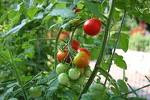Before the strawberry we have today there were wild strawberries which still grow in temperate zones all over the world. They have a completely different taste to garden strawberries and are somehow more succulent despite their small size. They may be white or red, and grow in out of sight places like the shrinking violet. They are of course related to the strawberry and so are members of the rose family of plants.
I used to be able to pick wild strawberries in the garden and along the roadside as well as in the woods, and know that they are best eaten freshly picked. Luckily I am not allergic to them as some people can be. Their leaves and roots as well as the flowers are similar to those o the garden strawberries and they have much the same medicinal value. Strawberry juice is astringent and can be used as a face whitener and diuretic.
 Traditionally tisanes were made of the leaves and roots to stop diarrhoea and dysentery. They have been used in many cultures over the centuries both for their medicinal properties and their flavour. Mediaeval stone masons carved strawberry motifs on pillars and cathedral and church altars and doorways as they were a symbol of purity and purification. During these times wild strawberries were cultivated for their medicinal value rather than to eat.
Traditionally tisanes were made of the leaves and roots to stop diarrhoea and dysentery. They have been used in many cultures over the centuries both for their medicinal properties and their flavour. Mediaeval stone masons carved strawberry motifs on pillars and cathedral and church altars and doorways as they were a symbol of purity and purification. During these times wild strawberries were cultivated for their medicinal value rather than to eat. The Romans had strawberries with grapes as fruit of choice in their festivals, and believed that they were good for the liver, spleen, throat infections, bad breath, gout and to dispel melancholia and fever among other ailments.
In the Renaissance people were eating them for their taste, and Ben Johnson writing a play in 1603 mentions them in the way we know them now (especially when visiting the tennis tournament in Wimbledon).
“A pot of strawberries gathered in the wood,
To mingle with your cream.”
A later poet, George Peele has these lines in his poem “The Old Wives Tale”
“Strawberries swimming in the cream
And schoolboys playing in the stream.”
Doctor William Butler, a writer in the 17th century famously remarked, “Doubtless God could have made a better berry, but doubtless, God never did.”
In Shakespeare’s play, “Othello,” Desdemona’s handkerchief, which was the indirect cause of her demise, was embroidered with a strawberry motif, the symbol of purity.
 Strawberries have vitamins, minerals, amino acids, bioflavonoids and phytonutrients which have potent antioxidant properties and are particularly good for preventing macular degeneration as are wimberries, being rich in vitamin A, C and E. They also contain zinc, potassium, copper, traces of selenium, and have been found to reduce the rate of reproduction of cancerous cells in the liver.
Strawberries have vitamins, minerals, amino acids, bioflavonoids and phytonutrients which have potent antioxidant properties and are particularly good for preventing macular degeneration as are wimberries, being rich in vitamin A, C and E. They also contain zinc, potassium, copper, traces of selenium, and have been found to reduce the rate of reproduction of cancerous cells in the liver. Culpeper says that strawberries are “singularly good for the healing of many ills” and they were symbols of healing. However, poor Anne Boleyn, Henry VIII’s second wife had a strawberry birth mark on her neck, which marked her, among the superstitious, as a witch. As strawberries are not only the symbol of purity, but also of passion, they were given to newly-weds in France along with powdered sugar, watery soured cream, and borage as an aphrodisiac, just in case they needed any extra help on their wedding night.
 Strawberries can be used to whiten the teeth and the skin, and are valuable in the cosmetic industry. They were once used to relieve sunburn, and were also considered to have anti-inflammatory properties and so good for arthritis and rheumatism. They also have useful diuretic properties. In other words, these delicious little fruit are very good for your health, so try to find some, but eat them in moderation as they can cause skin rashes and your tongue to become swollen.
Strawberries can be used to whiten the teeth and the skin, and are valuable in the cosmetic industry. They were once used to relieve sunburn, and were also considered to have anti-inflammatory properties and so good for arthritis and rheumatism. They also have useful diuretic properties. In other words, these delicious little fruit are very good for your health, so try to find some, but eat them in moderation as they can cause skin rashes and your tongue to become swollen.
















